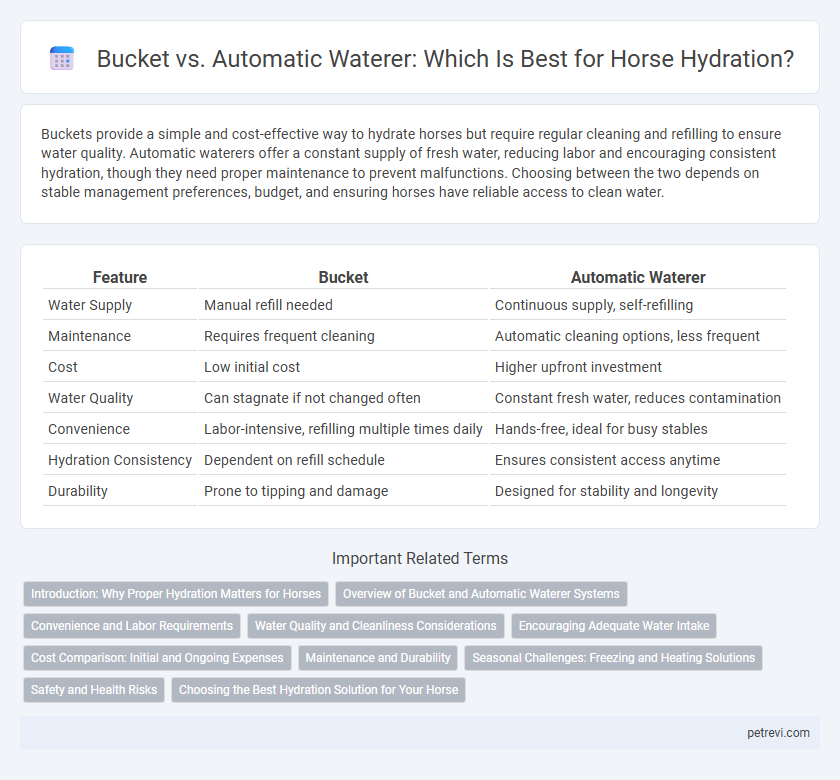Buckets provide a simple and cost-effective way to hydrate horses but require regular cleaning and refilling to ensure water quality. Automatic waterers offer a constant supply of fresh water, reducing labor and encouraging consistent hydration, though they need proper maintenance to prevent malfunctions. Choosing between the two depends on stable management preferences, budget, and ensuring horses have reliable access to clean water.
Table of Comparison
| Feature | Bucket | Automatic Waterer |
|---|---|---|
| Water Supply | Manual refill needed | Continuous supply, self-refilling |
| Maintenance | Requires frequent cleaning | Automatic cleaning options, less frequent |
| Cost | Low initial cost | Higher upfront investment |
| Water Quality | Can stagnate if not changed often | Constant fresh water, reduces contamination |
| Convenience | Labor-intensive, refilling multiple times daily | Hands-free, ideal for busy stables |
| Hydration Consistency | Dependent on refill schedule | Ensures consistent access anytime |
| Durability | Prone to tipping and damage | Designed for stability and longevity |
Introduction: Why Proper Hydration Matters for Horses
Proper hydration is crucial for horses to maintain optimal health, athletic performance, and digestive function. Dehydration can lead to colic, decreased stamina, and impaired thermoregulation, jeopardizing equine welfare. Ensuring consistent access to clean, fresh water through either buckets or automatic waterers supports hydration needs tailored to each horse's environment and activity level.
Overview of Bucket and Automatic Waterer Systems
Buckets provide a simple, cost-effective hydration solution for horses, requiring manual filling and regular cleaning to maintain water quality. Automatic waterer systems offer consistent access to fresh water through sensor-activated or float valve mechanisms, reducing labor and ensuring constant hydration. Both methods have advantages depending on farm size, horse activity, and maintenance preferences.
Convenience and Labor Requirements
Automatic waterers reduce labor by providing a constant supply of fresh water without manual refilling, ensuring horses stay hydrated effortlessly. Buckets require daily cleaning and filling, increasing time and effort for stable staff, especially in large equine facilities. Choosing automatic waterers enhances convenience and supports consistent hydration management in busy equine environments.
Water Quality and Cleanliness Considerations
Buckets require frequent cleaning to prevent algae growth and contamination, ensuring horses receive fresh water. Automatic waterers provide a continuous supply of filtered water, reducing the risk of bacterial buildup and maintaining consistent water quality. However, regular maintenance of automatic systems is essential to avoid mechanical failures that could compromise water cleanliness.
Encouraging Adequate Water Intake
Automatic waterers provide consistent, fresh water availability that encourages horses to drink more frequently, reducing dehydration risk. Buckets require manual refilling and monitoring, which can lead to irregular hydration and increased labor. Proper hydration supports digestion, joint health, and overall equine performance, making automatic waterers a more effective solution for maintaining adequate water intake.
Cost Comparison: Initial and Ongoing Expenses
Buckets for horse hydration usually have a low initial cost, often under $20, but require manual filling and regular cleaning, which can increase labor expenses over time. Automatic waterers involve a higher upfront investment, typically ranging from $200 to $600, due to installation and plumbing requirements, but reduce ongoing labor and water waste costs significantly. Over the long term, automatic waterers provide cost savings through consistent water availability and lower maintenance, offsetting the initial higher expenditure compared to buckets.
Maintenance and Durability
Buckets require frequent cleaning to prevent algae growth and bacteria buildup, demanding daily maintenance to ensure horse hydration safety. Automatic waterers, made of durable materials like stainless steel or heavy-duty plastic, offer long-lasting resistance to weather and damage with minimal upkeep. Proper maintenance of waterers extends their lifespan and reduces contamination risks, while buckets remain prone to wear and contamination without consistent care.
Seasonal Challenges: Freezing and Heating Solutions
Buckets offer simplicity but pose freezing risks during winter, requiring heated bucket options or manual water replacement to maintain horse hydration. Automatic waterers equipped with built-in heaters prevent ice formation, ensuring consistent water availability in cold climates. In summer, both systems require maintenance; buckets need frequent cleaning to prevent algae, while automatic waterers must have proper temperature regulation to keep water fresh.
Safety and Health Risks
Buckets require regular cleaning to prevent bacteria buildup, posing a risk of infections like salmonella in horses, while automatic waterers maintain fresher water but may malfunction and cause spills or electric hazards. Stagnant water in buckets can lead to mosquito breeding and increased disease transmission, whereas automatic waterers reduce this risk but need consistent maintenance to ensure safe, uncontaminated water flow. Horses drinking from buckets may accidentally ingest dirt or feces, increasing health risks, whereas automatic waterers provide cleaner hydration points but must be checked to avoid mechanical failures that compromise water quality.
Choosing the Best Hydration Solution for Your Horse
Choosing the best hydration solution for your horse depends on factors such as water cleanliness, ease of access, and maintenance requirements. Buckets provide a simple, low-cost option but require frequent cleaning and refilling to prevent contamination and dehydration risks. Automatic waterers offer consistent fresh water availability, reduce labor, and promote better hydration habits, making them ideal for busy horse owners or large pastures.
Bucket vs Automatic Waterer for Horse Hydration Infographic

 petrevi.com
petrevi.com